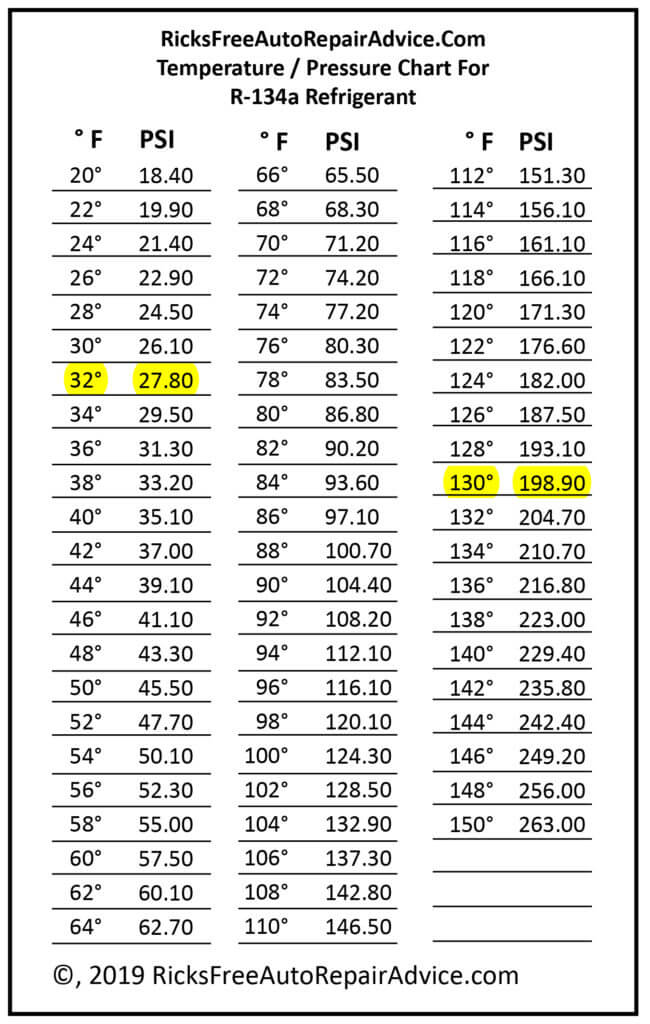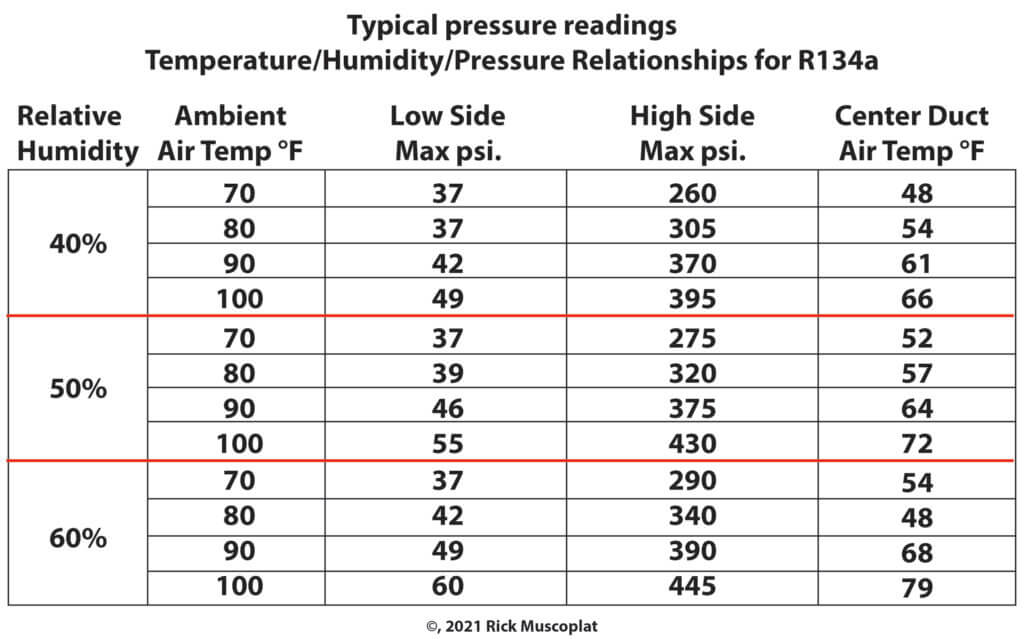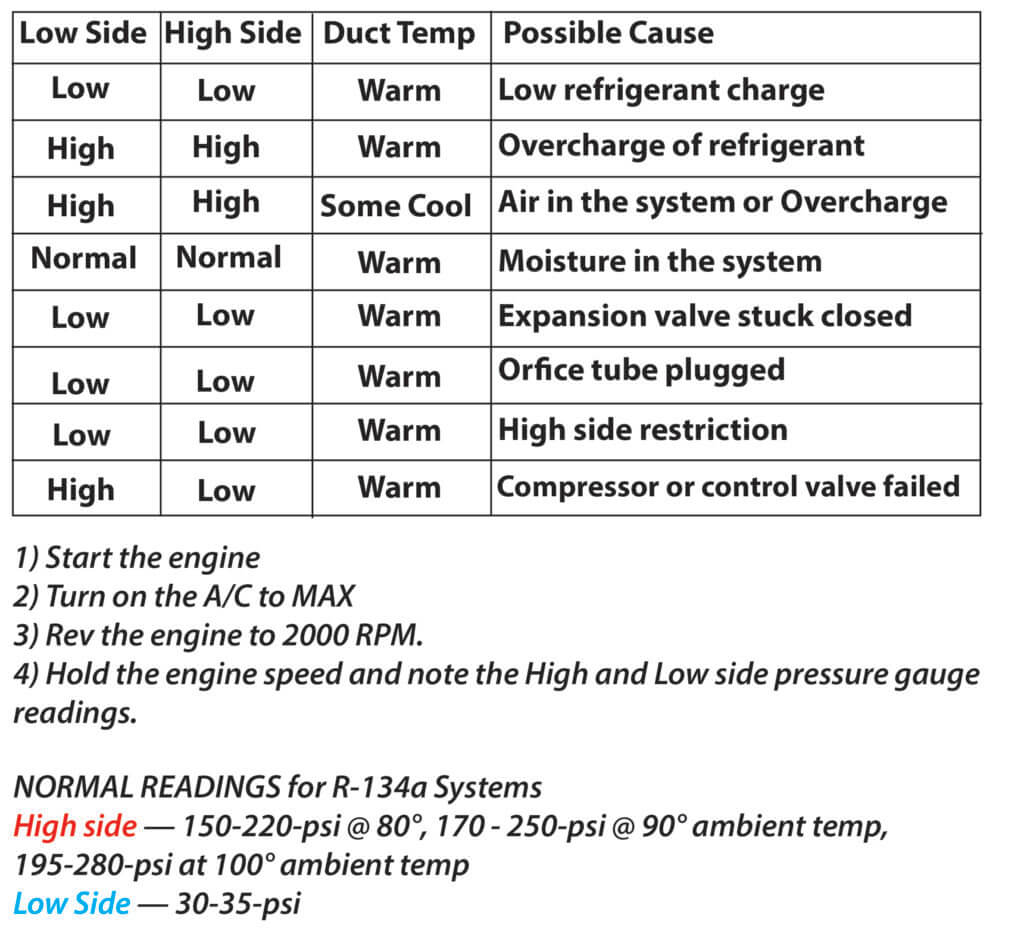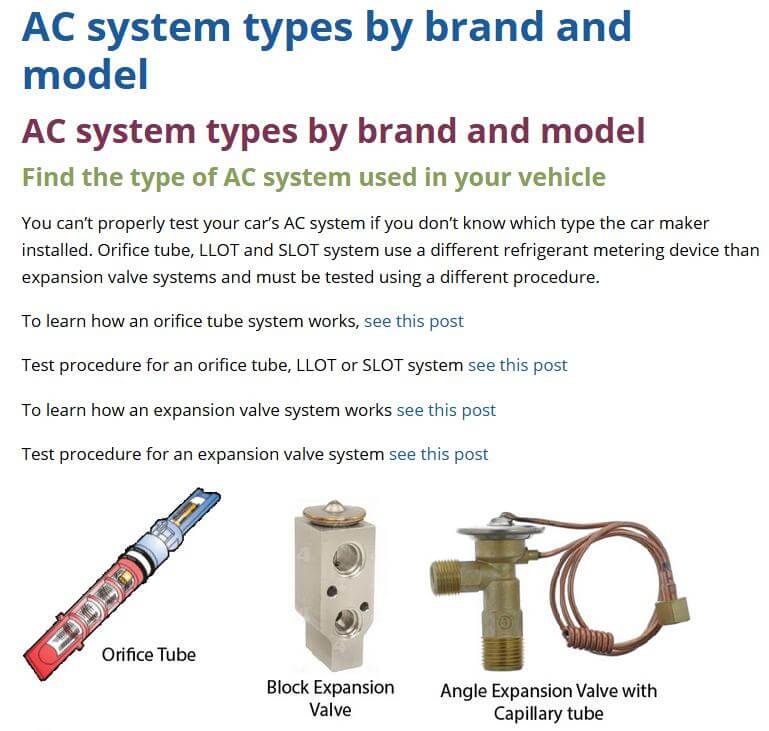AC Low on Refrigerant: How to Determine the Right Amount
Is your car’s AC low on refrigerant?
AC pressure readings alone can’t tell you if the system is fully charged
Let’s get this straight from the get-go; if all you have is the gauge on a DIY recharge kit, there’s NO way you can determine whether your car’s AC has the right amount of refrigerant. A low-side pressure reading, by itself, cannot tell you if the AC system is full. It can only tell you if the low side pressure is above or below the minimum pressure needed to overcome the low side cutoff switch.
Here’s what every DIYer doesn’t understand about pressure versus refrigerant capacity.
If you attach a pressure gauge to your engine’s fuel rail and you know that the fuel pressure is 55-psi. and the shop manual says that the recommended fuel pressure is 50-55-psi. does that tell you how much fuel is in your tank? No!
Tools you’ll need to determine if your car’s AC is low on refrigerant
• An AC manifold gauge set with quick connect adapters
• Temperature probes, dial thermometer, and a digital multimeter
So where do you start your AC diagnostic?
Start by checking static pressure
Attach your manifold gauge set to the high and low side ports (engine off for at least one hour). Measure the ambient temperature around the engine compartment and use the chart below to find what the static pressure should be.
If the static pressures are below what they should be for that ambient temperature, you can assume you car’s AC is low on charge. If the static pressure reading is below the low-pressure switch cutoff point, the compressor won’t operate. The low pressure cutoff switch values vary by carmaker.

Next look at these typical low-pressure switch minimum pressures (R-134a system)
• Switch closes and operates compressor clutch at 34-psi, opens and prevents compressor clutch operation when pressure is less than 10–psi
• Switch closes and operates compressor clutch at 47-psi, opens and prevents compressor clutch operation at less than 25–psi
• Switch closes and operates compressor clutch at 40-psi, opens and prevents compressor clutch operation at less than 32–psi
• Switch closes and operates compressor clutch at 34-psi, opens and prevents compressor clutch operation at less than 8–psi
• Switch closes and operates compressor clutch at 47-psi, opens and prevents compressor clutch operation at less than 25–psi
Check the shop manual for your vehicle to determine the minimum low side pressures for the cutoff switch to activate the compressor clutch.
If the static pressure reading is above the minimum for your vehicle and the compressor clutch doesn’t engage, the problem could be a faulty low-pressure switch, compressor clutch fuse, faulty clutch relay, clutch air gap, or wiring harness issues.
Next, check AC running pressures
First, determine which type of metering system your car uses; expansion valve or orifice tube. Click on the image below to open a new tab with a listing of metering systems for vehicle brands.
With your gauges still attached, start the engine and turn the car’s AC to MAX and close the windows.
Rev the engine to 2,000 and hold the RPM there.
Note the high and low side readings and refer to the temperature and humidity charts below.
Typical AC pressure readings for orifice tube and expansion valve systems at various ambient temperatures.
R-134a TEMPERATURE PRESSURE CHART FOR ORIFICE TUBE SYSTEM — ENGINE AND AC RUNNING
Ambient Temperature °F Low-Pressure Gauge High-Pressure Gauge
65°F Low side pressure 25-35 psi High side pressure 135-155 psi
70°F Low side pressure 35-40 psi High side pressure 145-160 psi
75°F Low side pressure 35-45 psi High side pressure 150-170 psi
80°F Low side pressure 40-50 psi High side pressure 175-210 psi
85°F Low side pressure 45-55 psi High side pressure 225-250 psi
90°F Low side pressure 45-55 psi High side pressure 250-270 psi
95°F Low side pressure 50.55 psi High side pressure 275.300 psi
100°F Low side pressure 50-55 psi High side pressure 315-325 psi
105°F Low side pressure 50-55 psi High side pressure 330-335 psi
110°F Low side pressure 50.55 psi High side pressure 340.345 psi
Ambient temp is the outside atmospheric temperature.
R-134a TEMPERATURE PRESSURE CHART FOR EXPANSION VALVE SYSTEM— ENGINE AND AC RUNNING
Ambient Temperature °F Low-Pressure Gauge High-Pressure Gauge
60°F Low side pressure 7-15 psi High side pressure 120-170 psi
70°F Low side pressure 7-15 psi High side pressure 150-250 psi
75°F Low side pressure 35-45 psi High side pressure 150-170 psi
80°F Low side pressure 40-50 psi High side pressure 175-210 psi
85°F Low side pressure 45-55 psi High side pressure 225-250 psi
90°F Low side pressure 45-55 psi High side pressure 250-270 psi
95°F Low side pressure 50.55 psi High side pressure 275.300 psi
100°F Low side pressure 50-55 psi High side pressure 315-325 psi
105°F Low side pressure 50-55 psi High side pressure 330-335 psi
110°F Low side pressure 50.55 psi High side pressure 340.345 psi
Adjust the readings for current ambient humidity
Humidity affects car AC performance. See this chart and adjust your running pressure readings accordingly.

Abnormal AC Gauge pressure readings

Low and high side pressures are about the same
(like 80-psi low side and 80-psi high side) AND you have to increase RPM quite a bit to get pressures into the normal range AND you notice the air only gets cold when you’re driving AND you’ve ruled out a low refrigerant charge or bad orifice tube/expansion valve.
Low and High AC gauge pressures are high with no fluctuation
The system is overcharged, there’s a lack of airflow across the condenser (clogged fins, radiator/condenser fans not working or not working at the proper speed), or you have air and moisture in the system.
Low and High AC pressures are lower than recommended on an orifice tube system
Causes: Low on refrigerant charge
In this case, the evaporator is starved for refrigerant. In a fixed orifice tube system, you want the evaporator almost completely full of refrigerant. When properly charged, a full evaporator will spill some boiling refrigerant into the accumulator where it will continue to vaporize before entering the compressor.
However, if the system is low on charge, the evaporator is only partially filled with refrigerant, so half of it will be cold and the other half hot. This often causes evaporator icing, where ice builds up on the evaporator. The ice blocks airflow and the low pressure triggers the low-pressure switch.
Low refrigerant charge causes superheat
Keep in mind that AC works when the refrigerant removes just enough heat from the air to cause the refrigerant to change from a liquid to a vapor. However, in a partially filled evaporator, the vapor then absorbs heat. This is called superheat and in an orifice tube system, the superheated refrigerant is what causes evaporator icing
In other words, the low refrigerant charge causes the refrigerant is in the system to sit too long in the evaporator. So the refrigerant picks up too much heat. First, it picks up enough heat to cause the refrigerant to change state from liquid to gas. THEN, the gas absorbs even more heat from the evaporator airflow, causing evaporator temperature to fall below the freezing point of water. Any ambient moisture immediately freezes on the evaporator fins.
Test for evaporator freeze-up
To test for evaporator freezing, turn off the engine and leave the vehicle for a while. When you return, examine the puddle size under the vehicle. A large puddle is an indication of evaporator ice that has melted and drained onto the ground.
OR, continue driving the vehicle with the blower on HIGH while monitoring airflow from the vents. Once the evaporator ices over, you should notice a dramatic reduction in airflow from the vents. The compressor will shut off once the low pressure triggers the low-pressure switch. The blower will melt the ice. Low side pressure will increase to the point where the low-pressure switch activates the compressor. Then you’ll get cold air again—until the evaporator ices up again. The pattern will repeat over and over.
NOTE: Low airflow across the evaporator, caused by a plugged cabin air filter, can mimic the symptoms of a low refrigerant charge. Also, a faulty evaporator temp sensor can prevent the system from shutting down once the evaporator has iced over.
Restricted or plugged orifice tube can also cause low pressure on an orifice tube system
Restriction in the low side of the system. For example, a restricted orifice tube will cause the compressor to suck, but the restriction/clog in the orifice tube prevents the full flow of refrigerant, causing evaporator starvation. Low side pressure drops below the low-pressure switch threshold, which shuts off the compressor.
What causes orifice tube restriction?
Debris is clogging the orifice tube screen
• Metallic wear particles from the compressor clog the orifice tube screen.
• Rubber hoses deteriorate over time and rubber particles clog the orifice tube screen.
• Moisture in the system reacts with the refrigerant and oil to form acids and sludge that clog orifice tube screen
• Moisture in the system that freezes at the orifice tube and restricts refrigerant flow through the orifice. An AC system leak allows moisture into the system. The moisture travels with the refrigerant. Since the temperature is near the freezing point of water right at the orifice tube, the moisture freezes, cutting off the flow of refrigerant into the evaporator.
To test for moisture: Turn AC off for 10-15 mins, then back on. If the gauge reading goes back to a very low suction-side reading, the orifice tube or expansion valve screen is likely frozen. If the gauge reading is normal when first turned on and stays normal for a few minutes, you get cold air and THEN low side goes low, that’s a sign of moisture in the system. Or, if you can access the orifice tube, apply heat to the orifice tube as you watch system pressures. if the system pressure returns to normal once you’ve applied heat to the orifice tube, the cause may be moisture in the system.
The orifice tube is the wrong size
• the orifice tube is too large
• the orifice tube has been replaced and the O-ring isn’t seated properly. In other words, the system can’t build pressure.
Low side AC pressure is VERY low and high side pressure is low: restriction
The expansion valve is stuck open so the system can’t build pressure or the thermal bulb that measures evaporator temp isn’t working properly and is causing the expansion valve to remain open.
Low and high side AC pressures are normal but the air isn’t cold
This may be a situation where the AC is working fine but the “heat is on,” diminishing the effects of the AC. This can be caused by a stuck air temperature door, faulty air temp/blend door actuator, or, in older systems, a stuck open heater control valve that’s running hot engine coolant into the heater core even though the heat is set to cold.
What to check:
Check heater control valve
Determine if the vehicle has a heater control valve. The valve is usually located under the hood and is opened and closed by a vacuum motor or cable. Look for heater hoses and either a cable or vacuum hoses running to a valve. Use a hand pump vacuum to operate the valve or move the cable by hand to close it off. Then check cooling.
Check air temperature or blend door and actuator
If the cabin air temp is controlled by an air temp/blend door, check the actuator operation to see if it moves as you change the temperature setting. In some cases, the fix can be as simple as replacing an actuator. If the actuator moves but the air door doesn’t try moving the door by hand. Many times the door can get stuck or break off from its hinges.
Check the cabin air filter
Yeah, it’s just like a furnace filter. If it’s clogged, it can restrict airflow. That, in turn, causes the evaporator to freeze up which shuts off the AC. Don’t skip this part. Many DIYers replace AC parts only to discover a clogged cabin air filter after spending hundreds on parts.
Check for a dirty evaporator coil
Leaves and dust can clog the fins of an evaporator coil, reducing its ability to remove heat from your car. To access the evaporator coil, remove the blower motor resistor, and take a peek inside. To clean the evaporator coil, use a foaming chemical cleaner.
©, 2020 Rick Muscoplat
Posted on by Rick Muscoplat

